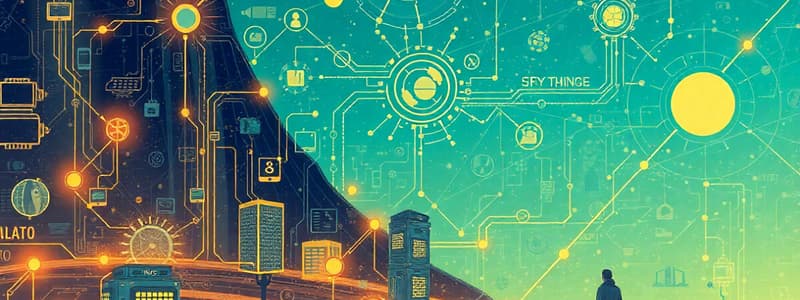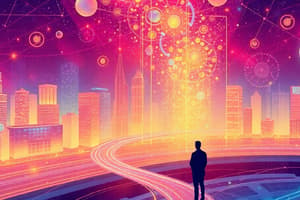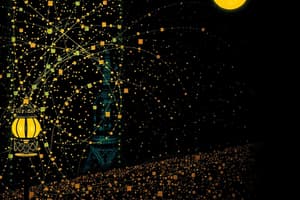Podcast
Questions and Answers
Who are the creators of the TCP/IP protocols?
Who are the creators of the TCP/IP protocols?
- John Romkey
- Vint Cerf and Bob Kahn (correct)
- Kevin Ashton
- Tim Berners-Lee
The term 'Internet of Things' was first coined by Tim Berners-Lee.
The term 'Internet of Things' was first coined by Tim Berners-Lee.
False (B)
What was the first IoT-like experiment mentioned?
What was the first IoT-like experiment mentioned?
A vending machine connected to report inventory.
Tim Berners-Lee invented the _______.
Tim Berners-Lee invented the _______.
Match the following inventions with their respective inventors or organizations:
Match the following inventions with their respective inventors or organizations:
What is the primary focus of Smart Rasa Group LTD.?
What is the primary focus of Smart Rasa Group LTD.?
The Internet of Things (IoT) marks the first revolution in technology.
The Internet of Things (IoT) marks the first revolution in technology.
Who is the founder and CEO of Smart Rasa Group LTD.?
Who is the founder and CEO of Smart Rasa Group LTD.?
The Internet of Things (IoT) is primarily related to _____ systems.
The Internet of Things (IoT) is primarily related to _____ systems.
Match the following historical events with their corresponding years in the context of IoT development:
Match the following historical events with their corresponding years in the context of IoT development:
In which decade did the concept of IoT begin to gain traction?
In which decade did the concept of IoT begin to gain traction?
What role does Babak Reihani specialize in besides being an entrepreneur?
What role does Babak Reihani specialize in besides being an entrepreneur?
IoT is considered unimportant in today's technology landscape.
IoT is considered unimportant in today's technology landscape.
Which of the following areas does IoT NOT apply to?
Which of the following areas does IoT NOT apply to?
IoT devices can only be used for monitoring home security.
IoT devices can only be used for monitoring home security.
Name one application of IoT in health.
Name one application of IoT in health.
IoT technology is one of the top four technologies in the _____ world.
IoT technology is one of the top four technologies in the _____ world.
Match the following IoT applications with their respective fields:
Match the following IoT applications with their respective fields:
By what year is it projected that there will be a total number of 35 active device connections?
By what year is it projected that there will be a total number of 35 active device connections?
IoT only applies to electronic devices used in homes.
IoT only applies to electronic devices used in homes.
List two benefits of IoT.
List two benefits of IoT.
Which of the following is a benefit of IoT?
Which of the following is a benefit of IoT?
Active sensors do not require an external power source to operate.
Active sensors do not require an external power source to operate.
Name one communication standard used in IoT.
Name one communication standard used in IoT.
One function of smart home IoT systems is ______ control.
One function of smart home IoT systems is ______ control.
Match the following types of sensors with their function:
Match the following types of sensors with their function:
What is the primary purpose of an Advanced Metering Infrastructure?
What is the primary purpose of an Advanced Metering Infrastructure?
LPWAN refers to Low Power Wide Area Network.
LPWAN refers to Low Power Wide Area Network.
What is one of the applications of IoT in smart cities?
What is one of the applications of IoT in smart cities?
IoT can help reduce ______ consumption in parking management.
IoT can help reduce ______ consumption in parking management.
Which sensor type measures light levels?
Which sensor type measures light levels?
Flashcards are hidden until you start studying
Study Notes
IoT Introduction
- The Internet of Things (IoT) is a network of physical devices, vehicles, home appliances, and other items embedded with electronics, software, sensors, actuators, and network connectivity that enables these objects to collect and exchange data.
- It is considered the fourth industrial revolution.
IoT Brief History and Evolution
-
1960s - 1970s:
- J.C.R. Licklider envisioned an interconnected computer network.
- The launch of ARPANET marked the beginning of the internet.
-
1980s - 1990s:
- Vint Cerf and Bob Kahn developed TCP/IP protocols.
- The first IoT-like experiment was conducted by David Nicolas, where a vending machine was connected to report its inventory.
-
1990s - 2000s:
- John Romkey connected the first toaster to the internet.
- Cambridge installed an online webcam to monitor a coffee pot.
- Tim Berners-Lee created the World Wide Web.
-
2000s - 2010s:
- Kevin Ashton coined the term "Internet of Things".
- LG introduced its smart refrigerator, while Google developed self-driving cars.
- Smart cities like Seoul and Singapore emerged.
-
2010s - 2020s:
- The number of active device connections increased significantly, reaching 35 billion.
- IoT is being used in various applications such as smart homes, smart cities, and industrial automation.
Why is IoT Important?
- Benefits of IoT:
- Automation and control: IoT enables automated processes for greater efficiency.
- Efficiency and savings: Optimizes operations and reduces resource consumption.
- Safety and comfort: Improves safety and enhances user convenience.
- Increased security: Provides enhanced security measures for physical assets.
- Environmental monitoring: Collects data to monitor and protect the environment.
- Gathering rich data: Enables data collection for analysis and insights.
- Reduces human fault: Minimizes human error by automating tasks.
IoT Architecture
- Layers:
- Devices: Sensors and actuators collecting or controlling physical data.
- Communication: Networks connecting devices and transmitting data.
- Platform: Cloud infrastructure managing data storage, processing, and analytics.
- Application: User-facing interfaces for interacting with IoT data and processes.
Key Components of IoT Platform
- Data Storage: Stores collected data securely and efficiently.
- Data Processing: Analyzes and processes data for actionable insights.
- Data Access and Sharing: Provides mechanisms for accessing and sharing data with authorized users.
- Analytics: Uses sophisticated algorithms to extract meaningful patterns and insights from the data.
IoT in the Real World
-
Smart Home:
- Control Lighting: Automated lighting control based on time, presence, or environmental factors.
- Power Controls: Smart plugs and switches for remote control and energy monitoring.
- Energy Monitors: Track energy consumption in the home for cost-saving measures.
- Security systems: Smart home security systems with cameras, sensors, and remote monitoring capabilities.
- Entertainment: Streamline entertainment systems with voice control and smart devices.
- Smart Irrigation: Automated irrigation systems based on weather conditions and soil moisture.
- Smart Pool: Smart features to control pool filtration, heating, and water levels.
-
Smart City & Resort:
- Irrigation System: Water conservation through efficient irrigation system management.
- Street Lighting Control: Automated control of street lights for energy savings.
- Asset management: Tracking and managing assets for optimal utilization.
- Monitoring Manhole & Bins: Monitoring the condition of city infrastructure for timely repairs and maintenance.
- Pool Management: Smart systems for pool cleaning, heating, and water quality.
- Electricity and Water Metering: Smart meters for accurate tracking of consumption and billing.
- Parking management: Automated parking systems for better utilization and ease of parking.
-
Parking Management System:
- Aims to reduce fuel consumption by helping drivers quickly find available parking spaces.
- Reduces operational costs, increases revenue, improves time management, and enhances convenience.
-
Advanced Metering Infrastructure (AMI):
- Provides advanced metering technologies for real-time monitoring of energy consumption and other utility services.
- Offers detailed information for improving efficiency, reducing waste, and managing resources effectively.
Types of sensors
-
Passive sensors:
- Inductance: LVDT (Linear Variable Differential Transformer)
- Capacitance: Piezo
- Resistance: NTC (Negative Temperature Coefficient), PTC (Positive Temperature Coefficient).
-
Active sensors:
- Communication Interfaces: CAN (Controller Area Network), I2C (Inter-Integrated Circuit), SPI (Serial Peripheral Interface), TTL (Transistor-Transistor Logic), RS485, RS232, USB, ETHERNET, WIEGAND, 1-WIRE
- Specific Sensor Types: CPS-30NOC15B Proximity Sensor, GY68 Pressure Sensor, BH1750 LUX Sensor, HC-SR05 Ultrasonic Sensor, CAX60 Encoder, Industrial Soil Moisture Sensor, Humidity and Temperature Sensor, Minivls-313 Laser Speed Sensor, APL Flow Meter, WG215 Flow Sensor, Digital Temperature Sensor (DS18B20), RS485 PM15PS
### Examples of IoT Devices
-
Sensors:
- Proximity Sensor
- Gas sensor
- Light Sensor
- Humidity Sensor
- Temperature Sensor
-
Actuators:
- Motorized Curtain
- Barrier (e.g., for gates)
- Lamp
- Motor
- AC (air conditioner)
Communication Protocols
-
Short-Range:
- Zigbee (WPAN - Wireless Personal Area Network)
- Wi-Fi (WLAN - Wireless Local Area Network)
- 6LowPAN (Low Power Wireless Personal Area Network)
-
Long-Range:
- LoRaWAN (Long Range Wide Area Network)
- NB-IoT (Narrowband Internet of Things - Cellular)
- LTE-M (Long Term Evolution for Machines - Cellular)
- 5G (Cellular)
Platforms and Applications
-
Platforms:
- Protocols: MQTT, CoAP, REST API, Custom protocols.
- Cloud Storage: Provides space for storing vast amounts of sensor data.
-
Applications:
- Dashboards: Visual representations of data collected from IoT devices.
- Mobile Applications: User-friendly interfaces for interacting with IoT systems.
- Data Analysis Tools: Analyze and interpret data to gain insights and make informed decisions.
Studying That Suits You
Use AI to generate personalized quizzes and flashcards to suit your learning preferences.




